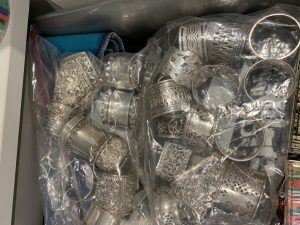Do you know what you really own? Do you know where every item is located? And if you had to, could you prove the existence and location of all of your possessions?
Imagine this scenario: You’ve just left a holiday party, wearing a pair of beautiful South Sea pearl earrings. On the walk to your car, your scarf gets tangled up with the clasp and one of the earrings comes unmoored and tumbles into the street, never to be found.
If you don’t have written documentation along with photographic evidence that the earrings existed, you may be out of luck. Both are crucial when it comes to proving your case for insurance or other purposes.
When you think about taking inventory of what you own, you may think a written inventory might suffice. But, as they say, a picture is indeed worth a thousand words. A comprehensive, clear photographic inventory combined with a detailed written record gives you powerful protection and peace of mind.
Clients approach me to document all sorts of items for a variety of reasons, which include:
- Protection against loss in the event of a fire, robbery, or natural disaster. (Did you really own 14 TVs and 6 computers? Even with only two people living in the house? Now you can prove it!)
- Proof of what you owned during and after a move, should the truck tip over on the road or things mysteriously go missing
- To back up endorsements in property and casualty insurance policies, primarily for non-itemized belongings such as sterling silver and jewelry
- Proof of the content of a tax-deductible donation
- Evidence of what forms part of a trust versus the estate of the deceased owner of the trust
- Itemization of objects that comprise an inheritance
- A way to make sure that the first child to enter your home after you pass does not take the emerald ring and then claim that it must have been sold ages ago
If you plan for the future at all (and you should; see Planned Versus Unplanned Giving and Hatred From the Grave, for example) photographic inventory documentation is key. Ideally, your inventory should be updated every 7-10 years, or sooner if things in your life and home change.
Case in point: A home and its contents were put into a trust many years ago. In the mid 80’s, the son inherited the trust of the home and its contents as of the day of inheritance. Thirty years later, the same trust was inherited by the son’s children. However, during the course of 30 some years, possessions were added to the contents of the house, and others were replaced as they wore out. So, what actually belongs in the trust that the son’s children inherited? What belongs in the son’s estate (vs the trust) which will be divided amongst the children and other beneficiaries? There is no clarity. The inventory hadn’t been updated. This scenario is not that unusual and legal complications could have easily been avoided.
Another case: A very large library was donated to a religious organization. It was necessary to document the books and to have proof of how many were in the gift. Preparing a written list would have taken months and would have been very expensive. It was much easier to capture the titles and, to a large extent, the condition, photographically.
And yet another case: A collection in excess of 500 pieces of Inuit sculpture was for sale. The collector had a very detailed written inventory that he created and continually updated as he purchased new sculptures. Every item was numbered. But—and there is always a but—written descriptions were inadequate for any potential buyers of all or part of the collection. In this situation, I was brought in to work my magic.
In some situations, an insurance agent will hire me and bring me in to document the contents of a client’s home or items covered by special endorsements. Since it is to their benefit to have possessions properly documented via photographs, the agent will pay my fee and offer my services as a gift to their client. In other instances, the agent will just strongly suggest that the client hire me.
Now, it’s time for a quiz! What would be the best method for creating a detailed, photographic inventory of the following collections? How would you organize the objects? How might you notate dimensions, dates of acquisition, original cost, and other vital details?
- A collection of more than 300 works-on-paper stored in map drawers with the original receipts
- A collection of two large bags of sterling silver napkin rings, acquired from various sources over many years
- A collection of 60+ signed and dated (in most cases) art-glass paper weights
Any ideas? Unsure as to how you’d tackle these projects? I am not. After years of conducting photographic inventory, I know exactly how I would handle each case to deliver detailed, organized, high-resolution documentation (with written back up when needed) that would leave no uncertainties or confusion.
Want to find out more? Want to see some examples? Get in touch!
Best wishes,
Sharon
646-784-3073
www.360demenager.com
Subscribe to Receive My Newsletter:


I’m very impressed by how you go about this but I’m not surprised. Go Sharon.